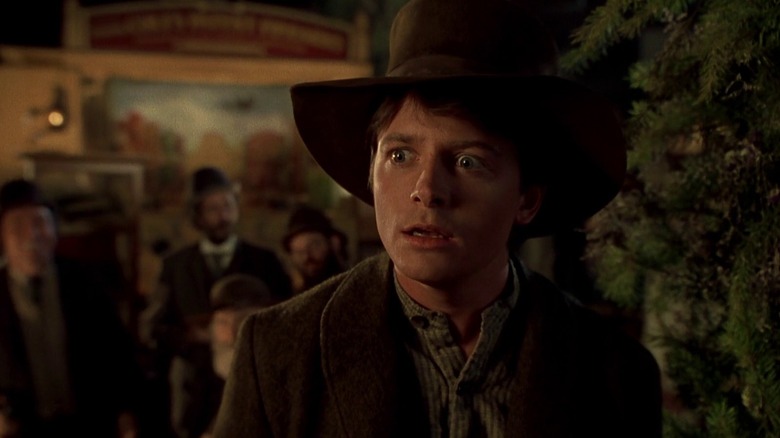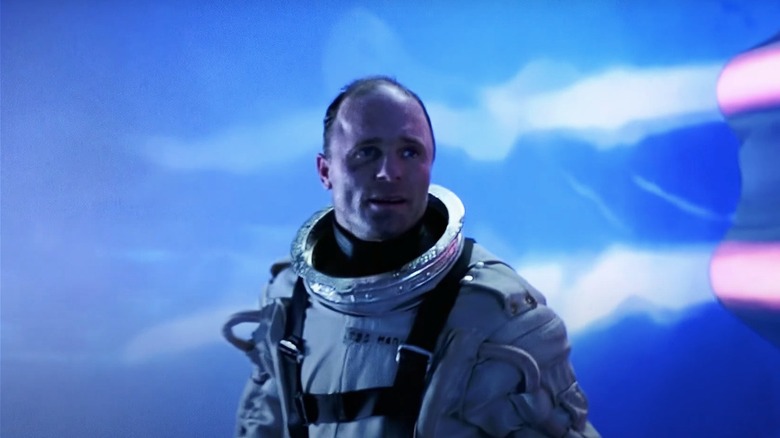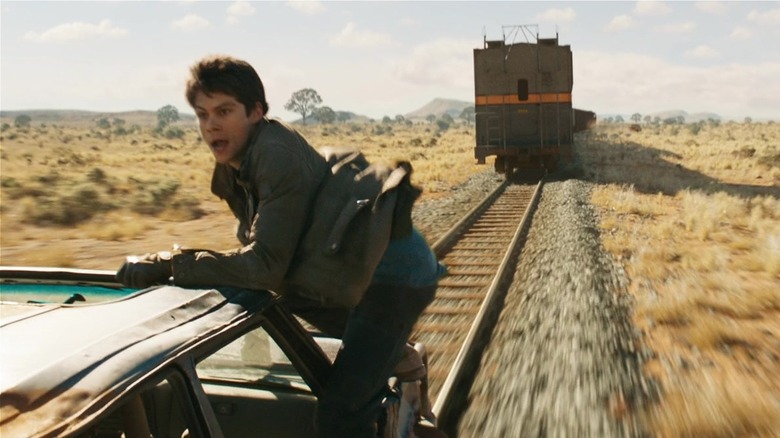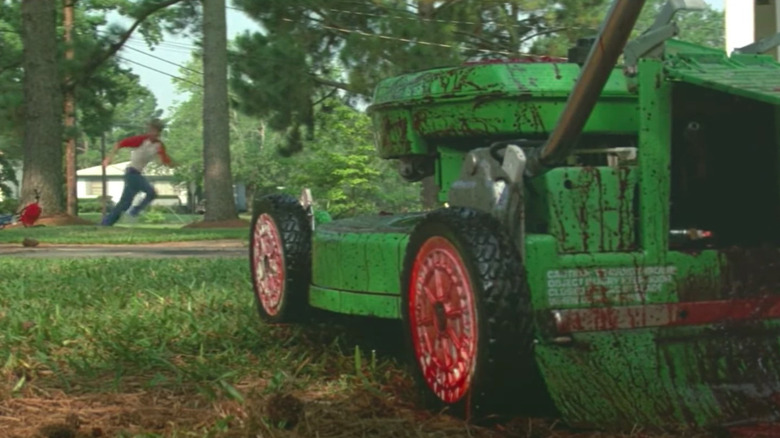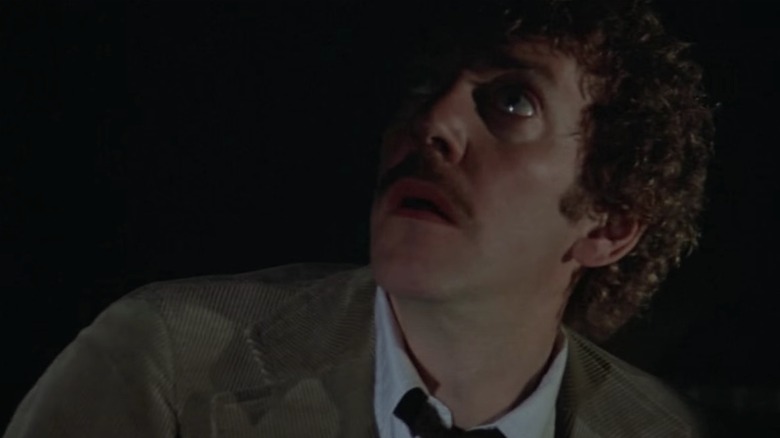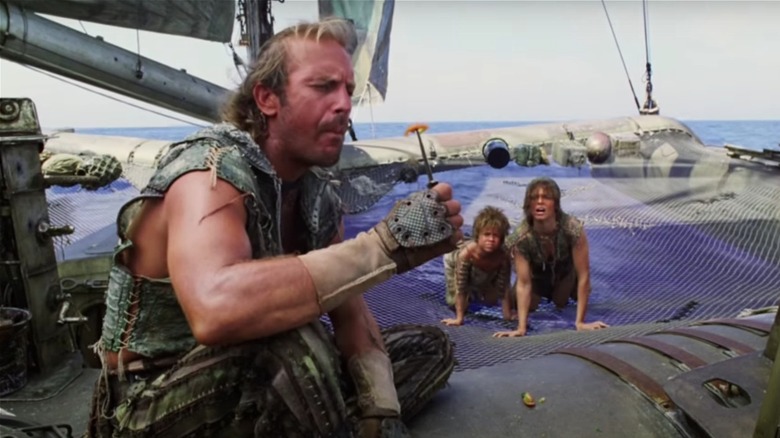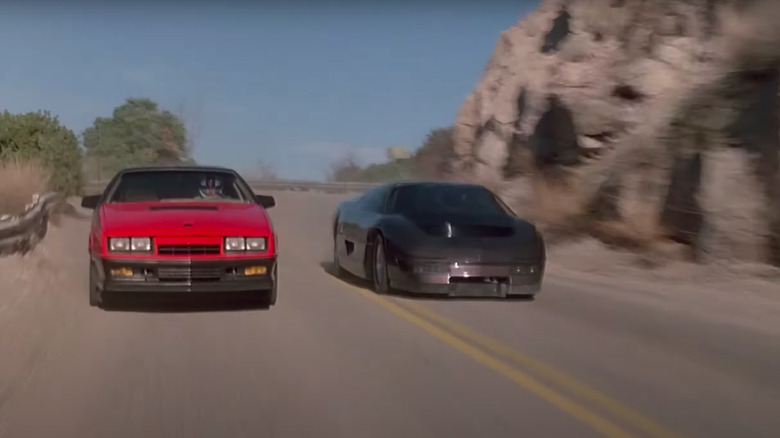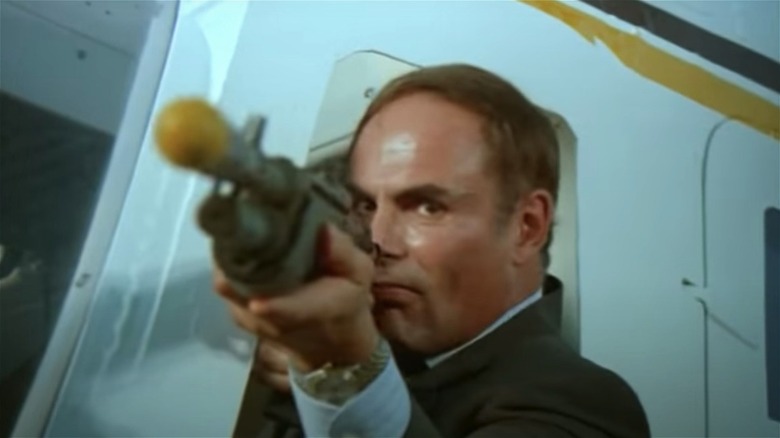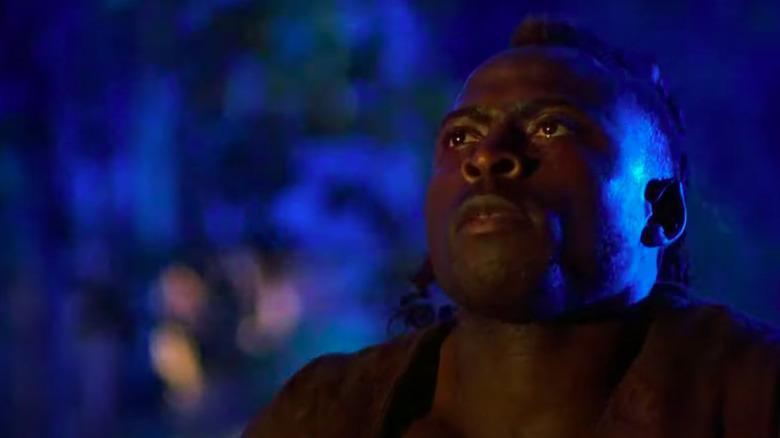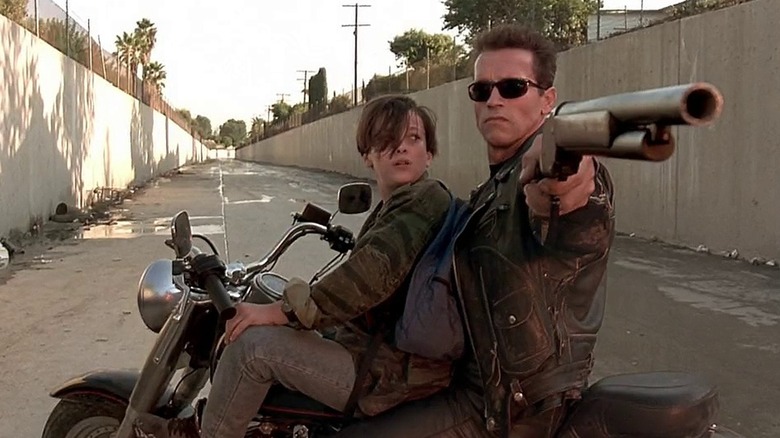Sci-Fi Movies That Pushed Things Too Far On Set
Science fiction is a fascinating film genre. It inspires dreams of extraterrestrial life, futuristic gadgets, and space travel. Today, this all seems more plausible than ever. Yet, besides reflecting society, sci-fi helps us evaluate our actions — and their consequences.
Creating scenes with nail-biting stunts requires a collaborative effort between actors and directors. Replacing stars with stunt performers due to their physical capabilities usually works but mishaps can still happen — both on and off camera. The film industry has seen an increase in accidents over the last decade despite the advancement of technology. According to the Los Angeles Times, from 2010 to 2019, 19 fatal injuries occurred on American film sets. As attorney Chris Deacon told the outlet, "If those engaged to work on set in whatever capacity are dying at the hands of the creative process, then something is fundamentally wrong in the production processes."
Sure, authenticity makes for a thrilling watch. That said, Hollywood should probably retire the adage, "Pain is temporary, film is forever." Case in point? Take a look at the following sci-fi movies that pushed things too far on set.
Twilight Zone: The Movie (1983)
Fans rejoiced in the early 1980s at the news of a big-screen adaptation of "The Twilight Zone." The project — "Twilight Zone: The Movie" — brought together Steven Spielberg, John Landis, George Miller, and Joe Dante, each of whom directed a segment. Three stories remade episodes of Rod Serling's show, but Landis' portion, "Time Out," was only partially based on an original episode. It resulted in catastrophe.
Questionable decisions abounded on the set in 1982. Renee Shin-Yi Chen and Myca Dinh Le, the child stars in "Time Out," worked illegally. As reported by The New York Times, child labor laws forbade kids from working late at night. To bypass this, producer George Folsey Jr. never added their names to the production's paperwork. He also paid them in cash. Even worse, live ammunition was used for the action sequences.
An obit in The New York Times revealed that disaster struck on the shoot's last night. During the fatal scene, Vic Morrow's character rescues Shin-Yi Chen and Dinh Le's characters from an American air raid. All three were supposed to escape safely from a pursuing helicopter. On-set explosions caused the pilot to lose control of his aircraft and it crashed into the actors (via History), killing them instantly. Landis and four other crew members were subsequently charged with involuntary manslaughter. Remarkably, all five were acquitted. Weeping, Landis left the witness stand, vowing never to involve his cast again in such a reckless stunt (via The New York Times).
The Abyss (1989)
The visual spectacles in James Cameron's movies are legendary, from the 12 dives he took to create his $40 million Titanic replica to the technological innovations used for "Avatar." He also demonstrates when optical opulence shouldn't be a priority. "The Abyss," Cameron's 1989 movie, almost proved fatal.
The film depicts a group of petroleum engineers assisting Navy SEALs on a top-secret mission. As they plunge 2,000 feet underwater to reach a nuclear sub, they encounter aquatic aliens. How was this filmed? As Syfy.com revealed, Cameron located an abandoned nuclear power plant in South Carolina. Inside was the primary reactor containment vessel – which the film's crew filled with 7.5 million gallons of water.
Camerons show just under half the movie underwater, so the cast and crew underwent a rigorous diving program. In addition to 70-hour work weeks, filming lasted six months. Stars Ed Harris and Mary Elizabeth Mastrantonio experienced their respective meltdowns. "We were guinea pigs," Harris told Entertainment Weekly, adding that he nearly drowned.
The director nearly plunged into his own abyss during production. One day, the first AD suddenly left the set while Cameron worked at the bottom of the tank (via "James Cameron: Interviews"). Running out of oxygen, he removed his gear and attempted to surface. A safety diver noticed his predicament and provided Cameron with a breathing regulator. Instead of air, Cameron took in water. After the diver misunderstood the filmmaker's panic and refused to let go, Cameron punched him and swam to safety.
Maze Runner: The Death Cure (2018)
"Teen Wolf" fans might remember Dylan O'Brien as Stiles Stilinski but the actor really broke out four years later in 2014. After starring as Thomas in "The Maze Runner," O'Brien snagged two more films in the franchise. Based on James Dashner's 2009 novel, these movies follow a group of teens trying to survive a vicious labyrinth in post-apocalyptic America.
With a combined budget of $157 million (via The Cinemaholic), you can bet that all three installments feature vile monsters and jaw-dropping stunts. O'Brien completed the first two movies unscathed but "Maze Runner: The Death Cure" almost killed him. According to The Hollywood Reporter, for one stunt, O'Brien was rigged atop a moving vehicle. Despite sporting a safety harness, he was thrown off and hit by another car. Vulture reported that O'Brien suffered a concussion, facial fractures, and brain trauma (among other injuries).
Months passed before filming resumed. Additionally, the star didn't speak out until the following year, in 2017. O'Brien told Vulture, "I had lost a lot of function, just in my daily routine." Along with his physical trauma, the actor also struggled mentally, dodging emails from producers impatiently waiting for his return. Remarkably, O'Brien bounced back. In 2017, he starred in the stunt-focused spy film, "American Assassin."
Æon Flux (2005)
Charlize Theron is no stranger to performing physical feats. Per The Hollywood Reporter, the South African-born star did 98% of her own stunts seen in "Atomic Blonde." Her turn as Andy in "The Old Guard" proved even more impressive. Amid multiple injuries on the set of the 2020 fantasy film, Theron forged on. As she told Entertainment Weekly, upon completing the project, she underwent three surgeries after discovering she had torn a thumb tendon.
Even before these roles, Theron was involved in an on-set accident that would have made most actors swear off stunt work forever. In 2005, director Karyn Kusama adapted the beloved animated TV series "Æon Flux" to the big screen. Theron played the titular character in the live-action sci-fi film, completing most of the fight scenes herself. Shockingly, one backflip resulted in Theron landing on her neck, almost paralyzing her (via StarPulse).
Production ceased for eight weeks while Theron recovered. During a chat with news.com.au in 2017, Theron described her mishap as a "freak accident." She explained, "I had eight years of pain management, where I just couldn't get rid of the spasms and the nerve damage." Given Theron's continued stunt work, her passion for her craft is evident.
Back to the Future Part II (1989)
Countless fans love the "Back to the Future" trilogy. Besides enduring themes and an endearing cast, the franchise also includes high-tech gadgets — many requiring intricate stunt work.
"Back to the Future Part II" introduced the popular hoverboard. Director Robert Zemeckis hired a professional stunt team, including Cheryl Wheeler-Dixon, to perform numerous airborne acrobatics. As detailed in the book "We Don't Need Roads: The Making of the Back to the Future Trilogy," the original stunt double playing Griff's female gang member backed out over safety concerns, prompting Wheeler-Dixon to step in. For the hoverboard chase scene, Griff (Thomas F. Wilson) and his posse burst through the Hill Valley Courthouse Mall window. However, this stunt nearly killed Wheeler-Dixon.
Four performers were wired to a crane that swung them through the window. Once inside, a crewmember would press a button to cut the wires, dropping them onto airbags. They were strapped in and sent flying after a few last-minute unrehearsed changes. Greg Tippie, the special effects member responsible for pushing the button, also changed his vantage point. Wheeler-Dixon realized she had swerved off course and crashed into a pillar as the scene unfolded. Tippie didn't see the accident — and pressed his button. In a scene that began about 60 feet in the air, the stuntwoman crashed onto the concrete. Despite suffering severe injuries, she survived. "If you had fallen backwards, and the back of your head hit the concrete, you'd be dead," Wheeler-Dixon's doctor remarked.
Back to the Future Part III (1990)
You'd think that after the horrific accident that left stuntwoman Cheryl Wheeler-Dixon hospitalized in "Back to the Future Part II," the crew for the trilogy's final installment would ensure everything ran smoothly. Think again. The 1990 sci-fi/western almost claimed the life of its leading man.
"Back to the Future Part III" had another unique twist, teleporting Marty McFly (Michael J. Fox) to 1885 to save Emmett "Doc" Brown (Christopher Lloyd). Upon arriving, Biff Tannen's great-grandfather, Buford (Thomas F. Wilson), attempts to hang our hero. While Doc comes to the rescue in the movie, it's filmmaker Robert Zemeckis who saved Fox in the near-fatal stunt. In Fox's memoir, "Lucky Man," he explains that he initially stood on a wooden box to perform the trick for the close-up shot. Fox felt the method lacked realism, so he proposed that he try the stunt without the box. Having practiced holding his hands between his neck and the rope (to allow room to breathe), Fox was ready for the real deal. "On the third I miscalculated the positioning of my hand," the actor wrote. "Noose around my neck, dangling from the gallows pole, my carotid artery was blocked, causing me briefly to pass out."
Zemeckis saw Fox was unconscious and rushed to help him. Without the director's quick intervention, Fox could have suffered a severe brain injury or even died from the stunt.
Dune (1984)
Everyone knows that David Lynch's 1984 adaptation of "Dune" bombed. Calling it a "big failure" in an interview years later, the filmmaker revealed his main takeaway from the project: "Don't make a film if it can't be the film you want to make. It's a joke and a sick joke, and it'll kill you." While Lynch is still alive and well today, "Dune" left actor Jürgen Prochnow with extreme facial scarring after a special effects mishap.
In one scene, Duke Leto Atreides (Prochnow) attempts to assassinate Baron Harkonnen (Kenneth McMillan) using a tooth implant filled with poison gas. Leto dies in the attempt, and the Baron escapes. Subsequently, a vision of his father's death occurs to the Duke's son, Paul (Kyle MacLachlan). The Baron tears Leto's cheek in the dream, releasing green gas.
Prochnow had a fake cheek attached to a tube to achieve this special effect. An off-camera crew member then pumped smoke that surfaced from the cheek (via "The Making of Dune"). Testing on both a dummy and Prochnow, everything appeared safe. When filming started and gas was emitted, Prochnow jumped up and ran off-camera, holding his smoking cheek. The makeup used over the fake cheek wasn't sealed properly, allowing smoke (and heat) to build up before McMillan ripped it open. Prochnow sustained second and first-degree burns from the accident.
Maximum Overdrive (1986)
Stephen King's stories have been adapted into countless movies. Interestingly, the author once tried his hand at directing. King helmed "Maximum Overdrive," based on his 1973 short story, "Trucks." It was a disaster, earning King a Razzie nomination for worst director. His cocaine addiction overshadowed his work, as he later revealed in "Hollywood's Stephen King." "I really didn't know what I was doing," he recalled. "Maximum Overdrive" not only flopped, it ensnared King in a bitter legal battle.
In the film, machines come to life and attack humans. A group of survivors hide out at the Dixie Boy Truck Stop, surrounded by semi-trucks waiting to turn them into roadkill. The plot sounds bizarre — and an on-set accident that eerily resembled it occurred.
Armando Nannuzzi, an Italian cameraman with 100-plus credits, shot "Maximum Overdrive." Early on, a young boy, Deke (Holter Graham), narrowly escapes a blood-soaked lawnmower. As court documents later detailed, Nannuzzi got on the ground and tilted his camera upward to make the lawnmower appear "larger and more threatening" (via The Washington Post). For this angle, wooden wedges were placed under the camera. The remote-controlled lawnmower's safety equipment was removed to make it look more deadly. The machine hit a wooden wedge as it neared Nannuzzi, causing a splinter to land in his "shooting eye." He sued King for $18 million, claiming the accident caused "severe and permanent damage." Nannuzzi received $975,000 in a 1992 settlement (via Deseret News).
Invasion of the Body Snatchers (1978)
The sci-fi classic "Invasion of the Body Snatchers" remains timeless. For decades, audiences have been terrified by the story's clever premise that emotionless alien clones are slowly replacing humans.
The original 1956 film and Philip Kaufman's 1978 remake are based on the 1955 novel "The Body Snatchers," but many consider the latter more gripping. The movie's impeccable cinematography and sound design amplify the viewer's overwhelming feelings of paranoia. To make this nightmare seem even more real, cinematographer Michael Chapman shot the entire film on location in San Francisco. As a result, unexpected events occurred on the city's streets.
As reported by HMV, leading man Donald Sutherland handled all his own stunts. Twice, his tenacity almost left him in critical condition. One scene saw Sutherland running out of a park and onto a road — and accidentally colliding with a Volkswagen Beetle. Rolling onto the car's hood, he reportedly locked eyes with the driver, who uttered, "Oh my God, not you." Likewise, Sutherland barely escaped the fireball explosion in the factory where the extraterrestrial clones are manufactured. A nearby extra wasn't so lucky and wound up in the hospital.
Waterworld (1995)
1995's "Waterworld" endured a famously nightmarish production. The Kevin Reynolds-directed flick originally had a $65 million budget — which soared to $175 million. While script rewrites and production delays plagued the sci-fi set, Mother Nature emerged as the primary foe. You see, "Waterworld" unfolds in 2500, when every continent is submerged underwater. It was, therefore, shot entirely on water.
The unpredictable weather caused many complications. In addition to relentless jellyfish stings, much of the cast and crew suffered from seasickness (via People). Kevin Costner almost drowned when he was strapped to a trimaran's mast for one scene. During a sudden storm, water violently pelted the actor for half an hour while crewmembers looked on helplessly. Costars Jeanne Tripplehorn and Tina Majorino fared no better. They were hurled overboard when the bowsprit on their trimaran snapped, prompting a rescue team to dive in after them.
"Waterworld" left emotional scars for many. "In retrospect, I realize it made me reluctant about films," reflected Tripplehorn in 2009 (via "Apocalypse on the Set"). Some folks couldn't even endure the production. The assistant director, special effects designer, and other crewmembers all agreed that this sinking ship wasn't worth their salt and quit.
The Wraith (1986)
Some still remember "The Wraith" as a distant 1980s fever dream. This genre-bending schlockfest stars Charlie Sheen as the titular otherworldly race car driver. Our hero arrives in Arizona to exact revenge on Packard Walsh (Nick Cassavetes) and his gang of car thieves. Relentlessly challenging them to drag races, The Wraith kills them one by one. With its banging metal soundtrack and drool-worthy muscle cars, the 1986 flick is a cliched smorgasbord of its time.
Unfortunately, the vast number of car chases made "The Wraith" a perilous shoot. Mount Lemmon (outside Tucson, Arizona) played host to one of these chases, with a 2.5-mile course set up on the twisty mountain road. "The cars that they built for us were very dangerous and hard to drive," recalled stunt coordinator Buddy Joe Hooker to The Spokesman-Review. He added, "We worked on them throughout the film, but you're doing high-speed stuff, seventy, eighty, ninety miles per hour with these cars that are wandering all over the road and have skeptical braking." The road had a massive 250-foot drop-off on one side – precisely where tragedy struck.
A camera car — overloaded with crewmembers, including camera operator Bruce Ingram – went down the road first. It lost control around a bend, crashing over the cliff's edge. "We looked down the road and there was just bodies everywhere," Hooker recalled. Ingram died in the accident, while seven others were injured.
Hands of Steel (1986)
The forgotten Italian sci-fi film "Hands of Steel" falls into the so-bad-it's-good category. Directed by Sergio Martino (most renowned for giallo films) and released in 1986, "Hands of Steel" stars Daniel Greene and John Saxon — the latter of whom you may remember from "A Nightmare on Elm Street." In the movie, Earth is a suffering wasteland and an evil industrialist (Saxon) sends a cyborg (Greene) to kill the leader of an ecological faction. In what ends up being a cheap imitation of "The Terminator," we discover that our antihero has a heart.
"Hands of Steel" ranks as a fine Italian exploitation flick, but one marred by tragedy. Filming near the Glen Canyon Dam in northern Arizona resulted in two fatalities. In one scene, a helicopter shoots a machine gun at an actor on the Navajo Bridge. As the Chicago Tribune reported, the chopper — with actor Claudio Cassinelli in it — hit the bridge. "The pilot tried to fly under the bridge but the rotors struck the bridge, and the helicopter fell into the water," explained Coconino County Sheriff's Lieutenant W.R. Anderson. Falling 400 feet, the pilot and Cassinelli were killed.
Cyborg (1989)
Following the success of 1988's "Bloodsport," Cannon Films tapped Jean-Claude Van Damme to star in "Cyborg," their then-upcoming cyberpunk martial arts film. Described by Roger Ebert as a low-budget mix of "Escape from New York" and "The Road Warrior," the 1989 movie tanked. The film proved so middling that even its star found himself unimpressed. "'Cyborg' I didn't like too much," Van Damme admitted to the Chicago Tribune after its release. The actor plays mercenary Gibson Rickenbacker in a distant dystopian future. He's hired to transport cyborg Pearl Prophet (Dayle Haddon) from New York to the CDC in Atlanta, as she holds the cure for humanity.
A martial arts and kickboxing expert, "The Muscles from Brussels" displayed his skills fighting baddies in the movie. However, he also may have pushed things too far. In a scene where he fought a group of pirates, Van Damme accidentally struck stuntman Jackson "Rock" Pinckney with a prop knife. According to a report in Black Belt, Pinckney lost sight in one eye, which led to his discharge from the military. Subsequently, he sued Van Damme for $800,000 plus punitive damages.
Pinckney claimed Van Damme caused the accident by recklessly trying to make the fight as realistic as possible. The action star denied this. "I never meant to hurt anybody in my entire life," Van Damme told the jury. "I felt very sorry. I felt mentally distraught." Pinckney ultimately received $487,500 in damages, per the Orlando Sentinel.
Terminator 2: Judgment Day (1991)
James Cameron got his A-list break with 1984's "The Terminator." After directing "Aliens" and "The Abyss," Cameron returned with his follow-up, "Terminator 2: Judgment Day." Many would argue that "T1" boasts a tighter story but the 1991 sequel made waves with its groundbreaking visual effects. In addition to the CGI, "T2" featured daring practical effects and stunt work.
"T2" remains an action classic. However, some of the film's most thrilling sequences put its stars at risk. Linda Hamilton, who plays Sarah Connor, suffered permanent hearing loss in one ear. In an interview with Blockbuster, Hamilton revealed that she forgot her earplugs while shooting the hospital elevator scene. Intense noise caused the actress to drop to the ground when the T-800 (Arnold Schwarzenegger) fired a gun. "Suddenly I was in agony," she recalled, noting that all the gunfire and noise left her with shell shock.
Schwarzenegger faced challenges, too. For his now-legendary shotgun twirl, Cameron and his crew crafted a modified prop gun with an enlarged lever. In the "Terminator 2: Judgment Day" DVD audio commentary, the director explained that Schwarzenegger accidentally picked up the wrong weapon for the stunt. He nearly broke three fingers as a result.
